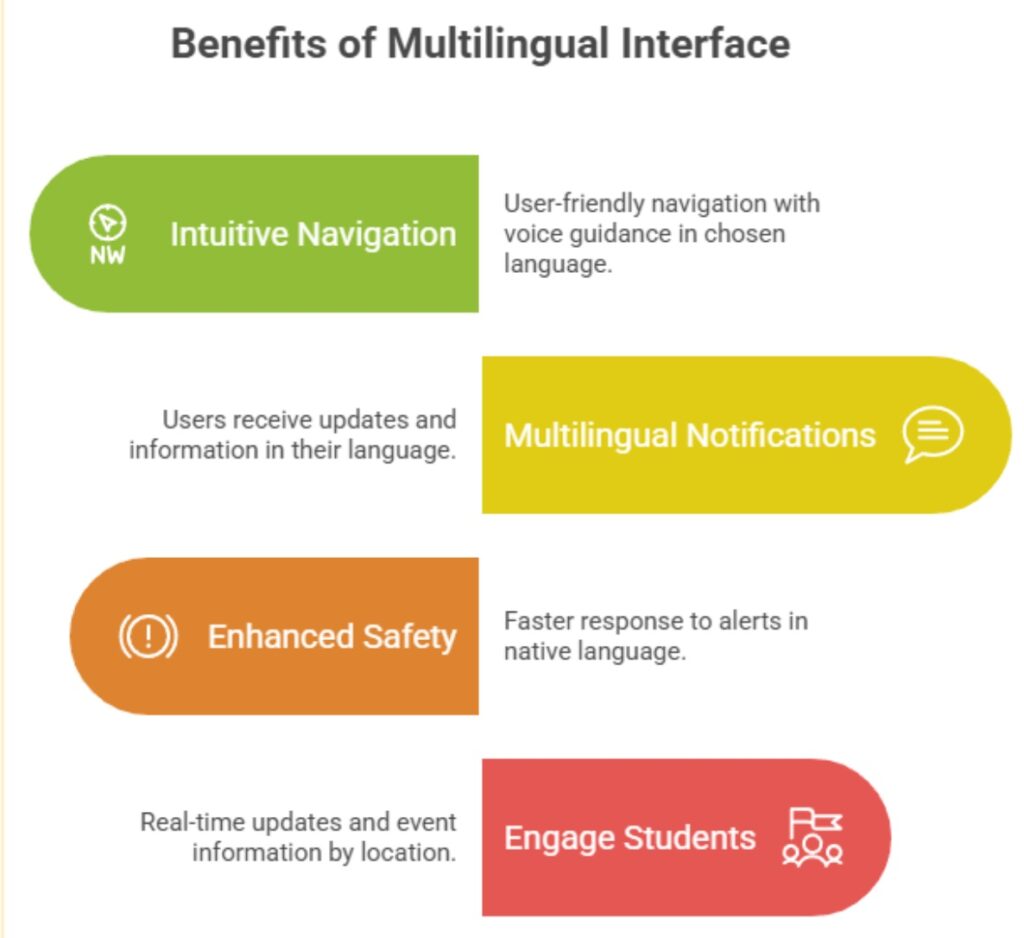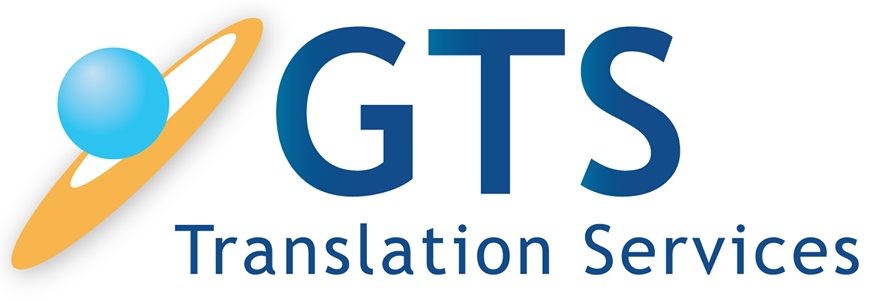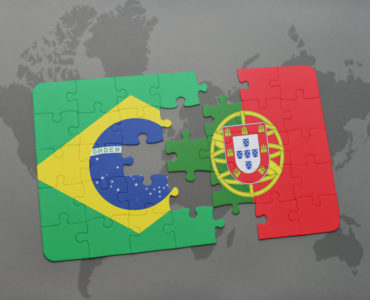by Dr. Alexey Panyov
Effective indoor navigation systems and seamless wayfinding—especially for international visitors—are crucial to the efficiency and competitiveness of large facilities, such as airports, universities, shopping malls, and hospitals. Multilingual user interfaces (Multilingual UIs) in indoor navigation systems have become vital tools for assisting people who speak various languages in quickly finding their way to destinations, specific rooms, and emergency exits. By providing clear instructions and information in the user’s native language, these interfaces help make interactions smoother, increase overall satisfaction, and reduce confusion and stress. In this article, we will present information on how multilingual user interfaces are changing indoor navigation. We will discuss the benefits they bring to organizations and best practices for their implementation.
Before we dive deeper, let’s clarify two key concepts. Indoor navigation is a state-of-the-art technology that helps visitors navigate inside buildings—places where GPS cannot reach. BLE beacons are tiny, battery-powered Bluetooth transmitters. Your phone “hears” several beacons, estimates its position on the floor plan from their signals, and then gives you turn-by-turn directions through the venue.
An indoor navigation system provides wayfinding within a building by using technologies like Wi-Fi or Bluetooth beacons to determine a user’s location. It relies on digital maps and route guidance algorithms to offer a user-friendly navigation experience, especially in large or complex environments where GPS signals are unreliable.
What Is a Multilingual Interface and Why It Matters for Apps
A multilingual interface refers to technology that enables multiple language options within an application, allowing users to switch between languages for easier and more convenient access to information. In the context of indoor navigation apps, this functionality enables easy adaptation of digital route maps and quick translation of place names, descriptions, and route guidance to points of interest.
The versatility of this technology has enabled its widespread adoption across various industries. Whether navigating a university campus, medical center, or airport, multilingual interfaces enhance the user experience, increase customer loyalty, and make mobile apps significantly easier to use.
The technology typically supports automatic translation from various languages, often the world’s most commonly spoken, and can also accommodate right-to-left (RTL) text formatting when needed.
When implementing a Multilingual UI in an indoor navigation solution, businesses can expect a wide range of benefits:
- Automatic detection of the user’s preferred language (based on device settings, geolocation, or manual selection)
- Localized maps and routes, including translated text, voice guidance, and intuitive icons
- Support for language-specific features, such as right-to-left (RTL) formatting, text expansion, and custom fonts
- Integration with machine translation and professional post-editing for rapid language scalability
The functionality of a Multilingual UI on indoor navigation platforms is similar to its use in other applications. Once the app is installed on a smartphone or computer, users can customize their settings, including selecting their preferred language. From then on, the system tailors content and directions to match the user’s language preference.
Which Businesses Benefit Most from Multilingual Indoor Navigation Apps
A multilingual interface in mobile applications is valuable across a wide range of industries. It is essential in airports, shopping malls, educational institutions, and healthcare facilities.
Universities
By implementing a Multilingual UI, indoor navigation app developers provide students, faculty, and campus visitors with the ability to interact with the system in a user-friendly and accessible manner. While most apps default to English, universities—especially large, international ones—host people from many countries who are more comfortable using an app in their native language.
A multilingual interface offers flexible solutions for navigating educational campuses, locating classrooms, and finding specific buildings. The system provides:
- Intuitive, user-friendly campus navigation, including voice guidance translated into the selected language.
- Multilingual notifications and informational messages to ensure users receive updates in a language they understand.
- Enhanced safety in emergencies, as people respond more quickly to alerts and instructions presented in their native language.
- Opportunities to engage new students in campus life by delivering real-time updates and event information based on their location.

Airports
Using a Multilingual UI helps create a personalized travel experience and eliminates the confusion of navigating an unfamiliar airport in a foreign country. Multilingual UIs in indoor navigation systems have become vital tools for helping people who speak various languages quickly find their way to destinations, specific rooms, and emergency exits. By offering clear directions and information in a user’s native language, these interfaces help minimize confusion and stress, making the user experience smoother and boosting overall satisfaction.
Shopping Malls
Mobile apps with multilingual interfaces are especially valuable in cities and resort areas that attract large numbers of international tourists. When visiting large shopping malls, foreign visitors may feel disoriented and unsure of where to go or how to find what they need. That’s where shopping mall navigation with a Multilingual UI comes in.
Users can easily locate retail areas, receive turn-by-turn directions, and get updates on promotions, discounts, and sales by simply selecting their preferred language. A multilingual interface not only enhances the shopping experience for international visitors but can also help boost the average purchase value for retailers.
Hospitals
Multilingual UIs allow healthcare facilities to personalize and deliver messages to patients who do not speak the local language. They also simplify indoor navigation for visitors within large hospitals, helping to create a safer and more patient-centered environment.
This system introduces a new standard of service by reducing the stress often associated with hospital visits and providing patients with a clear, comfortable way to navigate the facility.
The Role of Multilingual UIs in Indoor Navigation Systems
The global nature of the digital landscape, including indoor navigation, means that businesses serving diverse customer segments must prioritize multilingual application design. By doing so, they unlock several key advantages:
- Optimized flow and operational efficiency. Flexible routing in multiple languages reduces the burden on help desks and reception staff. With a multilingual mobile app, users can access the information they need in their preferred language and navigate the facility independently without relying on staff assistance.
- Faster orientation and reduced search time. Visitors to universities, stores, and other facilities can find their desired destination more quickly, helping to minimize crowding and long lines. Speed is especially critical in transportation hubs, where timely navigation can prevent passengers from missing flights or connections.
- Shorter wait times and fewer delays. Clear instructions in the user’s native language make self-service terminals quicker and easier to use, thereby improving overall efficiency. It also enhances the user experience and fosters trust in the organization.
- Faster response to navigation-related issues. People process and react more effectively to information in their native language, especially when it comes to real-time alerts or automated assistance. Multilingual UIs ensure that critical updates are understood and acted upon without confusion.
Key Benefits of Multilingual UIs for Real Estate and Business Environments
Integrating a multilingual user interface into a venue’s infrastructure facilitates better crowd management. It reduces the need for multilingual on-site staff or guides, making it a valuable solution for indoor navigation. When approached strategically, this technology offers several benefits:
- Increased visitor satisfaction and loyalty. Customers who can access information in a language they understand are more likely to trust and return to a business. A multilingual navigation system enhances the user experience, making visitors feel more comfortable and encouraging repeat visits, especially when they can use the app in their native language.
- Improved inclusivity and accessibility. Multilingual UIs enable businesses to meet regulatory standards, including the ADA, WCAG, and relevant European directives. By offering content in multiple languages, organizations make their services more accessible to international users and promote inclusion in public life for non-native speakers.
- More efficient use of resources. Integrating a Multilingual UI into a facility’s infrastructure supports better crowd management and reduces the need for multilingual staff or on-site guides. This is particularly valuable for businesses that regularly serve international visitors and currently rely on language-skilled personnel.
- Revenue growth and lower operational costs. Multilingual navigation can significantly increase conversion rates by making it easier for shoppers to find the right products in retail. This makes it easy for shoppers to understand product information and navigate the store, resulting in fewer complaints, fewer returns, and an overall better shopping experience.
Conclusion
User Experience (UX) is a critical factor in the efficiency of indoor navigation systems, especially in facilities with high foot traffic. A well-designed, multilingual user interface enhances UX by making navigation intuitive and accessible for diverse user groups. This not only helps companies tailor their apps to meet the needs of different users but also improves interactions with international customers. By prioritizing UX through multilingual support, businesses foster a more inclusive, customer-centric service environment.
About the Author
Dr. Alexey Panyov is a world-leading expert in navigation technology and software and is the CEO at Navigine.






